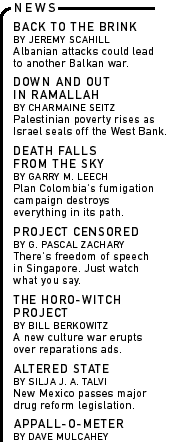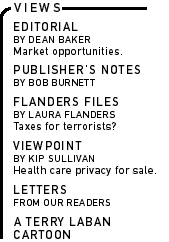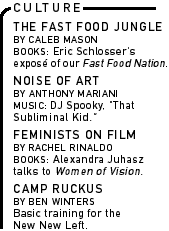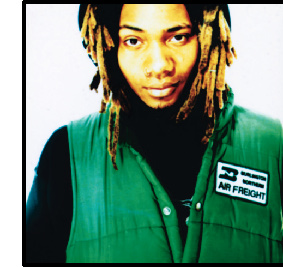

|

|

|

|
| |
|
|
|
There is a side of electronic music, specifically of the type DJ Spooky ("That Subliminal Kid") traffics in, that someday could lead to groundbreaking new, multimedia work. If Jackson Pollock were only around, he'd love this stuff. Pollock's greatest challenge was in responding with paint to what he saw and felt. The electronic artist today is entirely capable of diminishing the distance between emotion or idea, which we feel, and art, what we put down on paper or on polycarbonate disc. Summoning an entire symphony takes a push of a button. Understanding this only makes hearing artists like Spooky so heartbreaking. With all that equipment--and, we could suppose, big ideas about politics and peace--you'd think Spooky could articulate one honest idea. You keep waiting, but all you typically get is noise of both varieties, too-verbal and not-verbal-enough. Though he sometimes uses rappers in his songs, DJ Spooky (a.k.a. Paul Miller) is a silent sermonizer who doesn't rely on language for his lectures. He uses car horns, the clatter of subways pulling into stations, hip-hop beats, video game explosions, talking heads, the effluvium of everyday life (the hip-hop beats come from the throbbing Hyundai going down the avenue). Allegedly inside or on top of his sonic constructs are comments on community, waste culture, co-dependency and basically the rest of what's fucked up or peculiar about our digital age. Thing is, you can't necessarily tell all this from the boom-siss beats, computer bleeps or synth asides. You might have to just read the liner notes--which may or may not include footnotes to Derrida or be 23 pages long. This is why a museum is such a good place for Spooky. It is, as of late, where the
At the Whitney, the elevator opens to the fourth floor, where "BitStreams" is located, to a huge wall of blue tubes of light, stacked next to each other like a long row of telephone poles or huge outdoor bug zappers. Behind the wall are assorted headphones. The set connected to DJ Spooky's song, "ftp:>snd>," is, like all the other "songs" along the wall (including pieces by John Herndon of Tortoise and Iranian singer Sussan Deyhim), identified by a yellow tag. On it reads the artist's mission statement (excerpted here): "In his conceptual sound work, DJ Spooky attempts to critique the social aspects of electronic culture. Describing his compositional method as 'cybernetic improvisation,' DJ Spooky surveys city streets, collecting sounds with a portable MiniDisc recorder. He then uses his laptop and various software programs to create urban sound collages." Consider yourself well read. "ftp:>snd>" is sort of an "illbient" (meaning Spooky's knack for blending "ambient" with good vibes) brain massage. Made up of assorted, chopped and looped bits of traffic noise, "ftp:>snd>" is also a reminder of just how tedious listening to someone play with toys can be. "ftp:>snd>" could be considered an example of musique concr¸te, a 50-year-old development that makes use of everyday sounds to construct tone poems. And like most musique concréte, "ftp:>snd>" is not really about anything--though it is possibly a point of departure for one to contemplate the act of listening to musique concréte itself; the idea's significant contribution to art is making one face technological innovation head on. Is "ftp:>snd>" enjoyable, enlightening? Hardly. But as motivation to hear new, heretofore unimaginable sounds, it is sufficient. Someday, some electronic artist who wants to grapple with ideas
about e-culture will dazzle us with an electronic song that uses
technology as its basis, not necessarily as its only subject. DJ
Spooky isn't the one. For him technology is the be-all, end-all
of putting noise to tape in the first place. At the beginning of
"Grapheme: Ghetto of the Mind" off Subliminal
Minded: The E.P., Spooky takes an organic drum solo and
chops it into bits, leaving some notes bleeding in the air or stuttering
without pause. The effect is similar to what proponents of glitchwerks
pull off with broken CDs: The typical Spooky song brings the listener close to something resembling art but then shuts the door in his face. At the beginning of "The Revolution Will Be Streamed," off File Under Futurism, an album of Spooky's remixes of tracks by the Freight Elevator Quartet, synth gurgles and assorted bass tones coalesce into a wonderful atmosphere for the big beats to step into. The song appears to move in a logical direction, but then Spooky's fingers apparently begin to twitch. Sensible melodies get stomped on, groovy rhythms get deconstructed into crumbs and the entire infrastructure of what was fast becoming a likeable song buckles under so much pomo tinkering. This isn't to say Spooky isn't musical. He can be. Most of his tuneful songs, what with their extemporaneous raps and flowy, tangible beats, reach out to the hip-hop fan. Spooky's critically acclaimed Riddim Warfare is a blend of hip-hop and drum 'n' bass, and is relatively accessible. But with every outing Spooky seems to fight the conformist label. He has developed a persona for himself as an outsider who breaks the boundaries of melody and harmony--and who believes he can concoct or coerce melody out of any stack of layered percussive effects à la John Cage. Having intellectualized his way--self-consciously or not--to cult status, through various writings and criticisms (he has contributed to ArtByte and The Village Voice), Spooky is a flashpoint artist for any discussion on adventurous (read: noisy) music making. Yet Spooky can't be anything other than self-indulgent. What other
reason would he have for coming close to making music without actually
doing so other than for his own amusement or curiosity? The name
for this phenomenon is called "chickening out"; writing without
using verbs; crafting songs without music. While great for college
dissertations (or articles like this), this type of avoidance, in
music, amounts to a nose-thumb at people with ears and a desire
to listen to new stuff. But that's the culture of dissonance: full
of folk always shying away from facing a complexity or obstacle
(like writing a solid pop tune) yet never growing short of enough
adjectives to lament said obstacle's large weight and girth. Who
else would Spooky be "writing" songs like "ftp:>snd>" for if not
himself? We can't listen to them. They hurt. Then it must be for
the aliens. Who knows. Who cares. Anthony Mariani is a freelance music journalist whose work has appeared recently in The Village Voice, Vibe and Salon.
|


